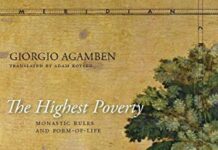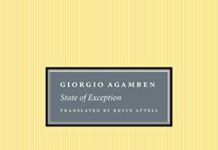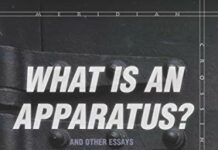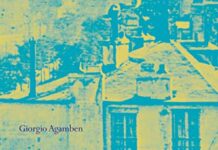
Ebook Info
- Published:
- Number of pages:
- Format: PDF
- File Size: 0.50 MB
- Authors: giorgio-agamben
Description
Rare book
User’s Reviews
Reviews from Amazon users which were colected at the time this book was published on the website:
⭐A magisterial meditation on the question of the “human” — used as an adjective. This short book is Agamben’s ‘Duino Elegies’: thalassically poetic and swirling with thought that hovers, indifferent to the gravity of common sense.The title refers to Heidegger’s term for the possibility of Dasein but Agamben is not doing a pro-Heidegger critique here. The Italian is thinking against the German: Agamben mentions that Heidegger was in fact the harshest separator of man and animal in modern thought, denying animals the very possibility of ever seeing the OFFEN (Open) that is (supposedly) available to man alone. But forget Heidegger–the book’s not about him. Agamben questions the very ground of Western thought that made it possible for Marty to make such an inhumane declaration at all.Agamben’s meditation begins with a medieval illustration that depicts the world after the end of the world (post-judgment) in which all the Saved are shown with various animal heads. Agamben wants to know what to make of this strange, unexplained overlapping of man and animal.And so he weaves a series of tales — each only a few pages long and Kafkaesque in their brevity, mysteriousness, and flash of insight — of how the idea that man and animal are two separate categories of being came to be. He weaves by unraveling the secret codes, the invisible knots that have held, and still hold, the most basic assumptions that drive Western thought, beginning with theology / philosophy and now, the bio-sciences.I was startled to learn how seemingly silly hair-splitting arguments of the theologians concerning the resurrected body could be so consequential later in the modern age in the formulation (and separation) of man and animal. An example: Would the intestines of the resurrected be full or empty? If full, then what to do about the problem of excrement in the Kingdom of God? If empty, is it because they are no longer needed? And if that is the case, what have them at all? Etc.(BTW, it was decided that there would be no animals in Heaven.)Agamben continues here what he began in his earlier works — namely the meaning and consequence of NAKED or RAW LIFE, devoid of any qualifiers, such as “human” such that a “human” being becomes just a living thing.Agamben states that his purpose is to expose and figure out a way to stop what he calls the ‘anthropological machine’ whose rise and history made possible the most “logical” outcome of such thinking: The Holocaust. But Agamben does not limt the phenomenon of the Holocaust only to what happened to the Jews –he extends it the entire spectrum of modern political thinking that permits the stripping of human beings of humanity. (See HOMO SACER.)Having said all that, I must confess, one cannot possibly do justice to this book by summarizing Agamben’s little molecules of thought, so compact and phosphorescent are they.
⭐The open provides us with the significant thought of what the human being is in the planet.
⭐good book, good seller!
⭐As a quick note on my position, I have reservations about Agamben’s work. Firstly, as an academic with his stated credentials (studying under Heidegger, assisting Italo Calvino, acquaintances with Derrida, Lyotard, Klossowski, etc.) and his professorial position, it is surprising his sparse use of citations. He often incorporates summations and quotations into his own text, which allows for a very fluid reading. It does, however, lead one to take him at his word. Secondly, I find Agamben to be overly abstract and opaque for a practical position for his chosen philosophical problems. He likes to use these general, hopeful terms like ‘coming community’ to point at some nebulous future state of being that is very unclear as to how it is supposed to come into being. Yes, with the abandonment of the ‘state of exception’ and for a qualitative approach to life and not simply it’s basic needs (‘bare life’). But how? And I mean exactly how? Why can’t he articulate a position on these dire circumstances with their overcoming? Agamben is very willing to diagnose the problem, in rather confusing terms at times, but never, ever to prescribe. I understand that one is solely responsible for defining one’s own being, but this is highly dubious at best for any sort of political praxis and leads me to question Agamben’s viability and dedication to his own prophetic outcomes. He suffers from some of the same criticisms leveled against Walter Benjamin, Foucault, and Derrida in my eyes. This is more troubling as he should know better as a result.This being said, “The Open” is a beautifully mind provoking read. Agamben delivers a quick and engaging overview of philosophical and theological debates as to what separates man from animal. It becomes very apparent that there has been a very thin line between the two. His narrative on early scientific classifications of man and other animals is a very fascinating read. The chapters dealing with Heidegger are particularly dense. These suffer too much from Agamben engaging in Heidegger’s ontological word games. It can be a rewarding slog though as he points to some very curious moments in Heidegger’s thought on the defining ontological basis of animals (this also being where the title of the book comes from). In short, the question “What is animal?” has been repeatedly answered with “All that is not man.” Consequently, “What is man?” has never been answered. This book left me with some rather disturbing questions related to my own thinking on the subject and a very critical mindset to bring to previously acquired and, hopefully, soon to always be acquired knowledge. And for this, I’ll err on the side of four instead of 3 with no halves. And this book deserves a half as it itself is only a half book.Meaning that this book didn’t appease my reservations about Agamben. Yet again, there is this pointing at – ? or this feeling of arriving at some great breakthrough that propels you through the book to the inevitable let down. I was left seriously wanting more and a little frustrated. And as this is a constant in reading Agamben for me, it unfortunately leads me to doubt the efficacy of his position. Of course, what that position is, exactly, is also very difficult to elucidate. OK, so man has never been adequately defined and therefore it’s definition becomes open. Now, how does one define it or even approach a definition to bring that lovely sounding ‘coming community’? And yet again, historical and philosophical points are dropped into the text on a faith basis. This leaves the reader to spend, at the very least, several hours in a library researching to verify or further explore the anecdotes Agamben addresses instead of a very quick, simple citation in the text that one could quickly look up. Agamben himself may have considerable credibility with his peers, but his text lacks it.
⭐Agamben is particularly hard to read here. There is a lot of aesthetics involved, and a lot of reference to theology. We had a really hard time explaining to non-Judeo-Christians in Japan what all this eschatology and body/mind stuff were about. And his style is more cryptic here than “Remnants of Auschwitz” or “Homo Sacer.” But that being said, I really appreciated the last 4 chapters of the book, where I finally got an idea of Agamben’s general project, and his vision for a human being that doesn’t try too hard to be what it is.
⭐very nice item
Keywords
Free Download the-open in PDF format
the-open PDF Free Download
Download the-open PDF Free
the-open PDF Free Download
Download the-open PDF
Free Download Ebook the-open




